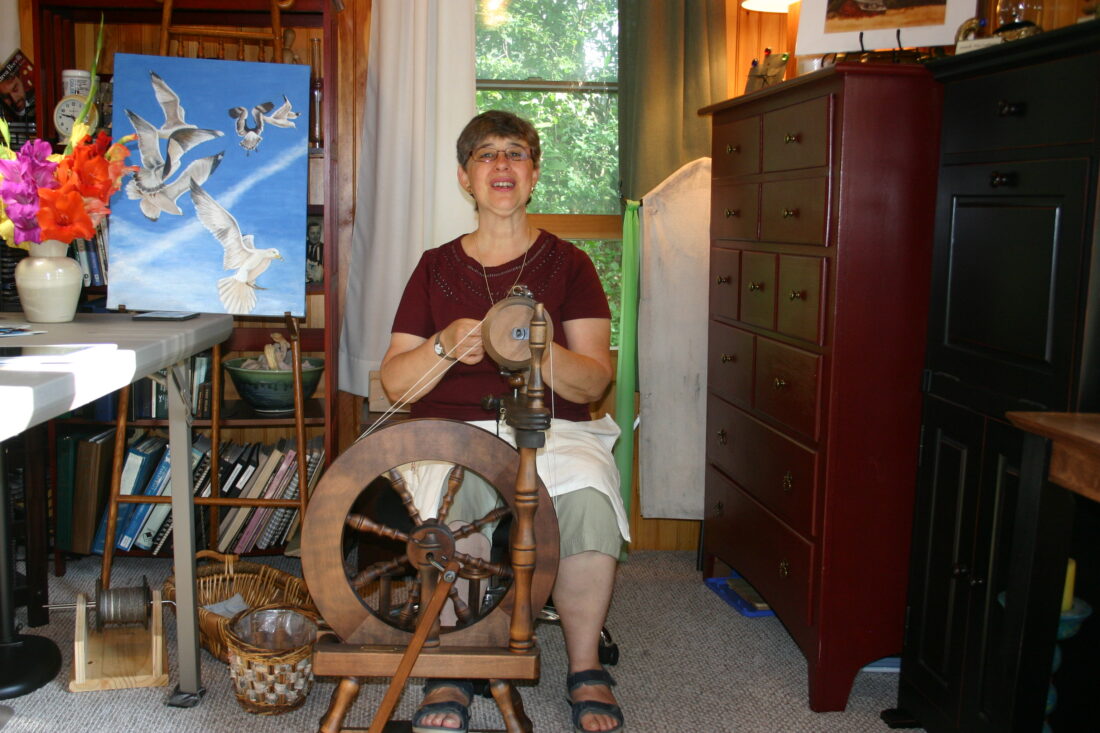Discovering the Keene Valley Porch Studio
- Ann Hearden spins wool to make yarn at the Keene Valley Porch Studio. (Provided photo — Martha Allen)
- Margaret Hearden shows a spindle. (Provided photo — Martha Allen)

Margaret Hearden shows a spindle. (Provided photo — Martha Allen)
Tucked away in a Keene Valley home behind tall firs and spreading shade trees, next door to the Roostercomb Inn, is the Keene Valley Porch Studio.
This small shop offers handspun yarn, original acrylic paintings and handmade gifts. Ann Hearden and her mother, Margaret Hearden, take care to attract attention and make their business visible to motorists on State route 73 by putting a large fluttering flag, a sign that is clearly legible from the road and lifesize lamb sculptures out on the lawn in front of the building.
Margaret and Ann opened the Porch Studio in June 2018. Since then, it has been open from June through Columbus Day. The two moved to the Adirondacks from Green Bay, Wisconsin, at the urging of relatives who were already settled in Keene Valley. At the time, Ann had been employed for 20 years as a nutritionist, and her mother, Margaret, an artist, was holding several shows a year. All the same, Margaret says, “We were ready for a new adventure.”
Margaret’s acrylic paintings, many of flowers, fruits, landscapes and other subjects taken from nature, are displayed on the walls, while greeting cards, bookmarks and pillows bear prints of the same images.
Other gifts, crafted by both women, include teddy bears, Christmas ornaments, knitted hats and scarves and a pair of tiny baby mittens, all handcrafted. Skeins of handspun wool worsted, ready for customers’ crochet hooks or knitting needles, hang on the wall. Miniature sheep, angels and geese are cunningly made from all kinds of materials, from dried gourds to Sculpey clay to paper mache. Some of these dangle from the branches of a small Christmas tree, to accommodate visitors who collect holiday ornaments during their summer travels. Knitted catnip mice are among the most popular small souvenirs for people visiting the area.

Ann Hearden spins wool to make yarn at the Keene Valley Porch Studio. (Provided photo — Martha Allen)
“I love working with my hands and being creative,” Ann said. She learned to spin at Heritage Hill Living History Museum in Green Bay. She buys lamb and alpaca wool both raw and as roving, which has already been cleaned and carded, from the nonprofit Dorothy Day Catholic Worker Farm in Pennsylvania, as well as from several local sources in Chateaugay, Onchiota and Jay.
Some of her vendors sell wool named after the individual sheep or alpaca who provided the fleece–for example Keela and Noonmark.
First, the raw wool must be picked clean from any grass, burrs or twigs the sheep or alpaca might have collected in its fleece along the way, and then washed several times in soapy water until the wash water comes clear.
After the wool has been cleaned, and before it is spun, Ann explained, it needs to be carded. Carding is a process of brushing clean fibers over opposing sets of short wire teeth, using two hand carders (they look somewhat like dog brushes), or a drum carder, operated with a hand crank. Carding organizes the fibers by aligning them in a uniformly parallel fashion, which prepares the wool for spinning. At this stage, when the wool has been picked, washed and carded, it is called roving. It is now ready to be spun into yarn.
Ann sits at her spinning wheel, explaining the process as she works. A hand spindle may also be used to twist the fibers into yarn.
Margaret’s father was born in Vermont, and she tells the story of how, as a young man, he left home, seeking his fortune in Illinois. His dream was to become a dairy farmer with a big farm and a four-horse plow. He didn’t come from a farming background, and his parents tried to discourage him from taking on such an arduous career, as his heart was not strong. He was not to be deterred, however.
He did become a dairy farmer, he did get that 4-horse plow, and he didn’t stop there, Margaret says. Always interested in innovation and technology, he was among the first in the nation to produce pasteurized, grade A milk.
Margaret was named after her grandmother, an artist who called herself a Sunday painter. Her mother hoped that she would take after “the Sunday painter” and become an artist as well.
She was working in an insurance office when a coworker recognized her talent and encouraged her to go to art school. She took the advice and traveled to Milwaukee, Wisconsin, to study at the Layton School of Art. She was there for only one year, however; her father’s death prevented her from continuing due to lack of funds.
Margaret laughed about an old letter she found, in which her mother, as a young woman with a new baby, referred to the two lambs she and her husband were raising as “a dirty nuisance.” It goes without saying that Ann and Margaret take a different view of sheep at the Porch Studio.



